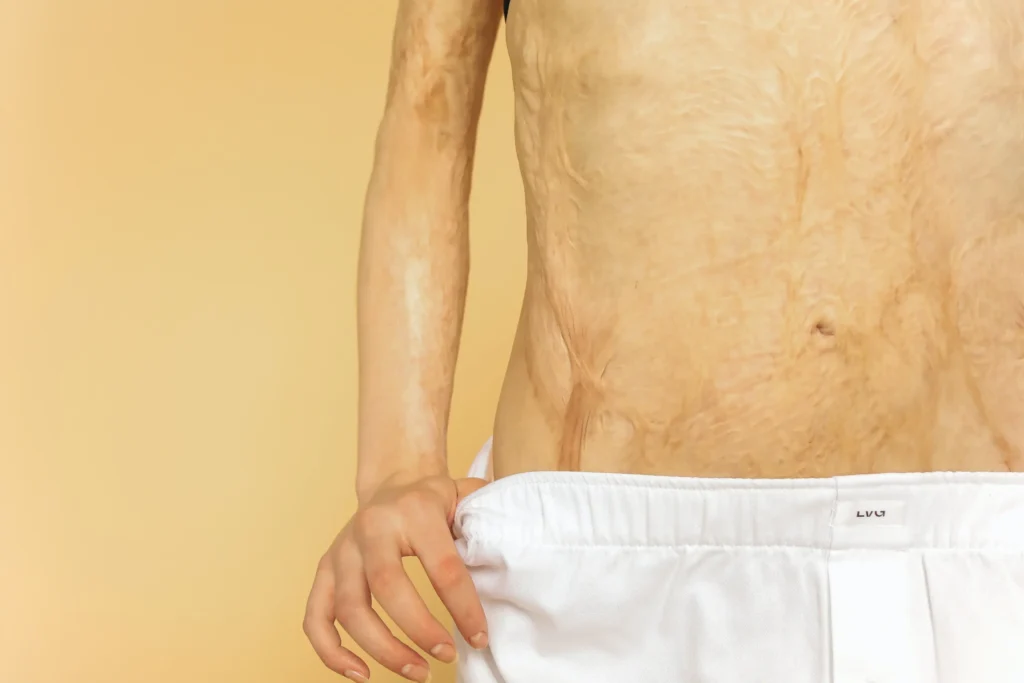Burns are a type of injury that occur when the skin is exposed to heat, electricity, chemicals, or radiation. Burns can range in severity from mild to life-threatening, depending on the depth of the burn and the percentage of the body that is affected.
There are three categories of burns based on their severity: first-degree, second-degree, and third-degree. First-degree burns affect only the outer layer of the skin and typically cause redness, pain, and swelling. Second-degree burns affect both the outer and underlying layers of the skin and can cause blisters, severe pain, and swelling. Third-degree burns are the most severe type of burn, affecting all layers of the skin and potentially causing damage to the underlying tissues, muscles, and bones.
TYPES OF BURNS
Burns can also be classified based on the cause of the injury, such as thermal burns from heat, chemical burns from exposure to corrosive substances, or electrical burns from contact with an electrical current. The severity and treatment of a burn depend on the cause and extent of the injury.
THERMAL BURNS
Thermal burns are a type of burn injury that occurs when the skin comes into contact with a heat source, such as fire, steam, hot liquids, or hot surfaces. The severity of a thermal burn depends on the temperature and duration of the exposure, as well as the area of the body that is affected.
First-degree thermal burns affect only the outer layer of the skin, while second-degree thermal burns can affect both the outer and underlying layers of the skin, and third-degree thermal burns are the most severe, affecting all layers of the skin and potentially causing damage to the underlying tissues, muscles, and bones.
Treatment
The treatment of thermal burns depends on the severity of the burn and can range from first aid measures to advanced medical treatment.
- First-degree thermal burns: These are minor burns that only affect the top layer of the skin, and they can often be treated at home. The goal of treatment is to relieve pain and prevent infection. First aid measures include running cool water over the affected area for at least 10-15 minutes to reduce swelling and pain. Aloe vera gel, over-the-counter pain relievers such as acetaminophen or ibuprofen, and topical creams or ointments containing lidocaine can also be used to relieve pain and promote healing. Avoid using ice or any greasy substances, as they can worsen the burn.
- Second-degree thermal burns: These affect both the outer and underlying layers of the skin and can cause blistering and severe pain. For larger second-degree burns or those on the face, hands, feet, or groin area, medical attention is recommended. Treatment for second-degree burns may include cleaning the wound, removing any dead tissue, and applying topical antibiotics and a dressing. Pain relief may be provided with over-the-counter or prescription pain medication.
- Third-degree thermal burns: These are the most severe type of burn and affect all layers of the skin, potentially causing damage to the underlying tissues, muscles, and bones. Third-degree burns always require immediate medical attention. Treatment may involve skin grafting, a process in which healthy skin from another area of the body is used to cover the wound, and surgery to prevent infection or other complications.
Overall, the goal of treating thermal burns is to minimize pain and prevent infection while promoting healing of the damaged skin. It’s important to seek medical attention if a burn is severe, covers a large area of the body, or if there are signs of infection, such as redness, warmth, or drainage from the wound.

RADIATION BURNS
Radiation burns are a type of skin injury that occur when the skin is exposed to high levels of radiation. This can happen from various sources, such as radiation therapy for cancer treatment, exposure to radioactive substances, or exposure to high levels of sunlight.
The severity of radiation burns depends on the duration and intensity of the exposure. Mild radiation burns can cause skin redness, tenderness, and itchiness, while more severe can cause blistering, peeling, and skin ulceration.
Treatment
The treatment of radiation burns depends on the severity of the burn and can range from first aid measures to advanced medical treatment. Here is a more detailed explanation of the various treatment options:
- First-degree radiation burns: These are mild burns that cause redness, tenderness, and itchiness. Treatment usually involves using cool compresses, topical creams containing aloe vera or hydrocortisone, and over-the-counter pain relievers such as acetaminophen or ibuprofen. It is important to avoid further exposure to the radiation source to allow the skin to heal.
- Second-degree radiation burns: These are more severe and can cause blistering, peeling, and skin ulceration. Treatment may include wound care, such as cleaning the affected area and applying topical antibiotics and a dressing to prevent infection. Over-the-counter or prescription pain medication may be used to manage pain. In more severe cases, surgery or skin grafting may be necessary.
- Third-degree radiation burns: These are the most severe type of radiation burn and can cause deep tissue damage and potentially life-threatening complications. Treatment for third-degree burns may involve skin grafting, reconstructive surgery, and aggressive wound care to prevent infection and promote healing.
In addition to medical treatment, it is important to take steps to prevent further exposure to the radiation source to allow the skin to heal. This may involve avoiding certain activities or using protective gear during radiation therapy or exposure to radioactive substances. Sun protection measures, such as wearing protective clothing, using sunscreen, and staying out of direct sunlight, can also help prevent sunburn and long-term skin damage.
Overall, the treatment of radiation burns aims to minimize pain, prevent infection, and promote healing of the damaged skin. It’s important to seek medical attention if a burn is severe, covers a large area of the body, or if there are signs of infection, such as redness, warmth, or drainage from the wound.

CHEMICAL BURNS
Chemical burns are skin injuries that occur when the skin comes into contact with a hazardous chemical substance. These substances can be found in many different settings, such as at home, in the workplace, or in an industrial environment.
The severity of a chemical burn depends on the type of chemical, the duration of exposure, and the amount of the chemical that comes into contact with the skin. Mild chemical burns can cause skin redness and irritation, while more severe can cause blistering, tissue damage, and potentially life-threatening complications.
Treatment
The treatment of chemical burns depends on the severity of the burn and the type of chemical that caused the injury. Here are the general steps for treating this condition:
- Remove the source of the chemical: The first step in treating a chemical burn is to remove the source of the chemical from the skin. This may involve rinsing the affected area with water for 20 minutes or longer, depending on the type of chemical.
- Assess the severity of the burn: Chemical burns can range from mild to severe, depending on the type of chemical and the duration of exposure.
- Seek medical attention: If the chemical burn is severe or covers a large area of the body, it is important to seek medical attention immediately. Call for emergency medical services or go to the nearest hospital.
- Remove contaminated clothing and jewelry: If the affected area is covered by clothing or jewelry, it is important to remove them to prevent further exposure to the chemical.
- Clean the affected area: Once the chemical has been removed from the skin, it is important to clean the affected area with mild soap and water. This can help to remove any remaining chemicals and reduce the risk of infection.
- Apply topical treatments: Depending on the severity of the burn, topical treatments such as creams, ointments, or dressings may be applied to the affected area to promote healing and reduce pain.
- Manage pain: Over-the-counter pain relievers or prescription medications may be used to manage pain associated with chemical burns.
- Prevent infection: It is important to keep the affected area clean and covered with a dressing to reduce the risk of infection. Antibiotics may be prescribed to prevent or treat infections.
Overall, the treatment of chemical burns requires prompt action to remove the chemical from the skin, assess the severity of the burn, and seek medical attention if necessary. It is important to take steps to prevent it by handling hazardous substances safely and wearing appropriate protective gear.
ELECTRICAL BURNS
Electrical burns are skin injuries that occur when an electrical current passes through the body, causing tissue damage. Electrical burns can be caused by contact with electrical wires, appliances, or lightning strikes.
The severity of the burn depends on the amount of electrical current that passes through the body, the duration of exposure, and the path that the current takes. It can cause tissue damage, muscle and nerve injury, and potentially life-threatening complications.
Treatment
The treatment of electrical burns depends on the severity of the burn and the extent of the damage caused by the electrical current. Here are the general steps for treating it:
- Remove the source of electricity: The first step in treating an electrical burn is to remove the source of electricity. This may involve turning off the electrical current, unplugging the device, or using a non-conductive material to separate the victim from the electrical source.
- Assess the severity of the burn: Electrical burns can range from mild to severe, depending on the amount of electricity that passed through the body and the duration of exposure. Severerity can cause tissue damage, muscle and nerve injury, and potentially life-threatening complications.
- Seek medical attention: If the electrical burn is severe or covers a large area of the body, it is important to seek medical attention immediately. Call for emergency medical services or go to the nearest hospital.
- Assess for other injuries: It can cause muscle spasms, falls, and other injuries. It is important to assess the victim for any other injuries that may have occurred during the electrical shock.
- Clean the affected area: Once the electrical current has been removed, it is important to clean the affected area with mild soap and water. This can help to reduce the risk of infection.
- Apply topical treatments: Depending on the severity of the burn, topical treatments such as creams, ointments, or dressings may be applied to the affected area to promote healing and reduce pain.
- Manage pain: Over-the-counter pain relievers or prescription medications may be used to manage pain associated with electrical burns.
- Monitor for complications: Electrical burns can cause complications such as infection, nerve damage, and tissue death. It is important to monitor the affected area for signs of these complications and seek medical attention if necessary.
Overall, the treatment of electrical burns requires prompt action to remove the source of electricity, assess the severity of the burn, and seek medical attention if necessary. It is important to take steps to prevent electrical burns by avoiding contact with electrical sources, using electrical equipment safely, and seeking medical attention immediately if an electrical injury occurs.